From Morocco to Bound: How lesbians are portrayed in mainstream movies (Part 2/4)
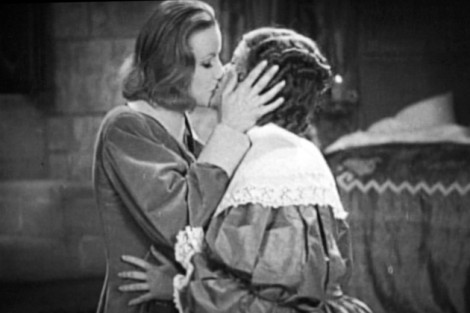
The relative openness of the 1910’s, 20’s and early 30’s – when movies contained many supporting homosexual characters, even if often just for comic effect – was squelched by the conservatism creeping into society, thanks in part to the advent of sound and detailed dialog. Where before the vaguely meaningful looks and brief inter-titles had made even risqué scenes palatable to sensitive audiences – and who probably missed references to sexual content they weren’t familiar with – “talkies” now spelled out most of the “sordid” details and got many a set of knickers in a twist.
A series of movie star sex scandals didn’t help either (most notably that of Roscoe “Fatty” Arbuckle, who was accused of raping and accidently killing a young woman). In a hurry to fix their morally questionable reputation, Hollywood moguls called in leaders of the Presbyterian and Catholic churches and in 1930 brought the Motion Picture Production Code into effect (also called the Hays Code after the head censor in charge of it, Will H. Hays).
As part of these new “moral” standards, for the next four decades lesbians were found in movies only at the sidelines – as a series of increasingly disturbing (and often disturbed) characters. The fate of these characters was of course always an unhappy one and often ended in death. Any young lesbian looking for a good onscreen role model during this time had no chance at all.
Part 2: In which we’re portrayed as creepy, disgusting & self-loathing – and naturally die at the end.
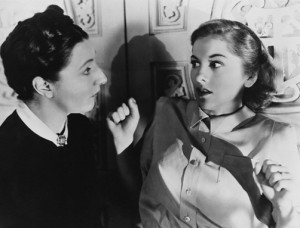 Rebecca, 1940
Rebecca, 1940
Directed by Alfred Hitchcock; starring Joan Fontaine, Laurence Olivier and Judith Anderson
“When a naive young woman marries a rich widower and settles in his gigantic mansion, she finds the memory of the first wife maintaining a grip on her husband and the servants.” From imdb.com.
Alfred Hitchcock always loved to add an element of creepy sexuality to his movies, and none of his inventions is creepier than his version of Mrs. Danvers. Even though the original character – as written by Daphne du Maurier for her novel – is also obsessed by Rebecca de Winter, Hitchcock dialled up the housekeeper’s freaky quality. When Mrs. Danvers shows the new Mrs. De Winter the room where she keeps Rebecca’s things in a kind of shrine, she lovingly runs her fingers through her deceased employer’s lingerie drawer as if the poor woman were still wearing them.
 Caged, 1950
Caged, 1950
Directed by John Cromwell; starring Eleanor Parker, Agnes Moorehead and Hope Emerson
“A naive nineteen year old widow becomes coarsened and cynical when she is sent to a woman’s prison and is exposed to hardened criminals and sadistic guards.” From imdb.com.
In keeping with traditions also established by the pulp fiction novels of the time, lesbian characters are introduced as a danger to be encountered by young women straying from the right path – and a warning against what happens when their morals become too loose.
Marie gets married too young to a wastrel who involves her in a robbery. He gets killed and she goes to jail, where she becomes the victim of a predatory butch matron, whose sadistic methods turn Marie into a hard, cynical woman. Although other (straight) women try to save Marie, they are no match for the evils of the matron – who of course has a bad end.
 All About Eve, 1950
All About Eve, 1950
Directed by Joseph Mankiewicz; starring Bette Davis, Anne Baxter and George Sanders
“An ingénue insinuates herself in to the company of an established but aging stage actress and her circle of theater friends.” From imdb.com
Described as “the mousy one with the trench coat and the funny hat”, Eve, with her Machiavellian manipulation of those around her on her climb to stardom, is easily identified as the bad guy. But to make Eve even less appealing audiences of the time, her character was made a lesbian – a fact confirmed by director Joseph Mankiewicz’s biographer, Ken Geist. Eve not only gazes lovingly at her idol Margot Channing, there’s also a subtle scene with a boarding house roommate who helps Eve hatch a side-plot, and at the end of the movie Eve invites a female fan to stay the night.
In a studio interview (that is: set up, scripted and controlled by the studio) included in a trailer for the movie, Bette Davis describes Eve as a woman with “…insatiable ambition and talent; an improbable person with contempt for humanity and an inability to love or be loved.” A perfect example of just what Hollywood thought of lesbians at the time.
 The Children’s hour, 1961
The Children’s hour, 1961
Directed by William Wyler; starring Audrey Hepburn, Shirley MacLaine and James Garner
“A troublemaking student at a girls’ school accuses two teachers of being lesbians.” From imdb.com.
In this second adaptation from play by Lillian Hellman (the first, 1936’s “These Three”, not only had all mention of lesbianism removed from it, but the marketing campaign forbade anyone to mention its original source – and thereby the original story), the makers went back to Hellman’s plotline: two women (Audrey Hepburn and Shirley MacLaine) running a boarding school for girls are accused by a pupil of having an affair.
Although its open discussion of lesbianism began a wave that would eventually help break down the restricted Hays Code in 1968, and although the fact it even approached the subject on film was pioneering, MacLaine’s sad character (the look on her face on the movie poster gives everything away) spends far too much time crying and finding herself disgusting. It turns out she actually is in love with her best friend, but Hepburn refuses to believe such “horrible” rumours about her are true.
“The Children’s Hour” reflects attitudes of the period by perpetuating – and expanding on – the stereotype of the sad, self-loathing lesbian who eventually commits suicide. Having come a long way since then, MacLaine apologised for this portrayal in the 1995 documentary “The Celluloid Closet”.

The Killing of Sister George, 1968
Directed by Robert Aldrich; starring Beryl Reid, Susannah York and Coral Browne
“George lives with her lover, Childie, and plays a cheerful district nurse in a BBC soap opera. However, her character is to be killed off, and George realises that the only other job she can get is the voice of a cow in a children’s tv programme. Her life begins to fall apart as Childie has an affair with a predatory tv producer.” From imdb.com.
In one of the most hideous screen portrayals of lesbian couple, we have the stereotype of the loud, obnoxious dyke (although she does have a few good one-liners) who behaves sadistically towards her girlfriend (and abuses two nuns in a taxi!), and the sad childish femme who cries a lot and is easy prey for the next strong-willed lesbian who comes along.
As the first movie ever to ever include an explicit sex scene between two women, it earned it an “X” rating from the movie industry’s MPAA and therefore limited release in theatres – in effect killing the film itself at the box office. Not necessarily a bad thing.
Next month:
The emancipating 1970’s and 80’s slowly lead to improvement in Hollywood’s inclusion of gay women in film, but not without a bit of “dykesploitation” along the way.


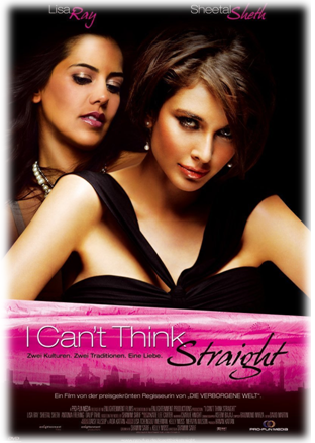
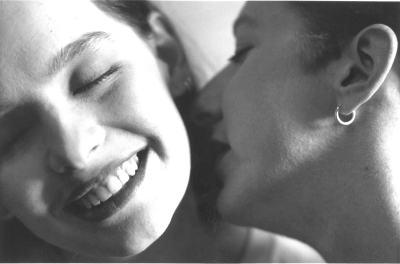
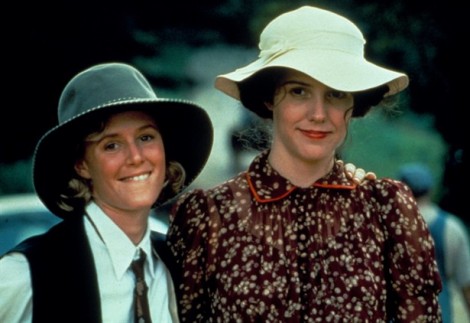
No Comment